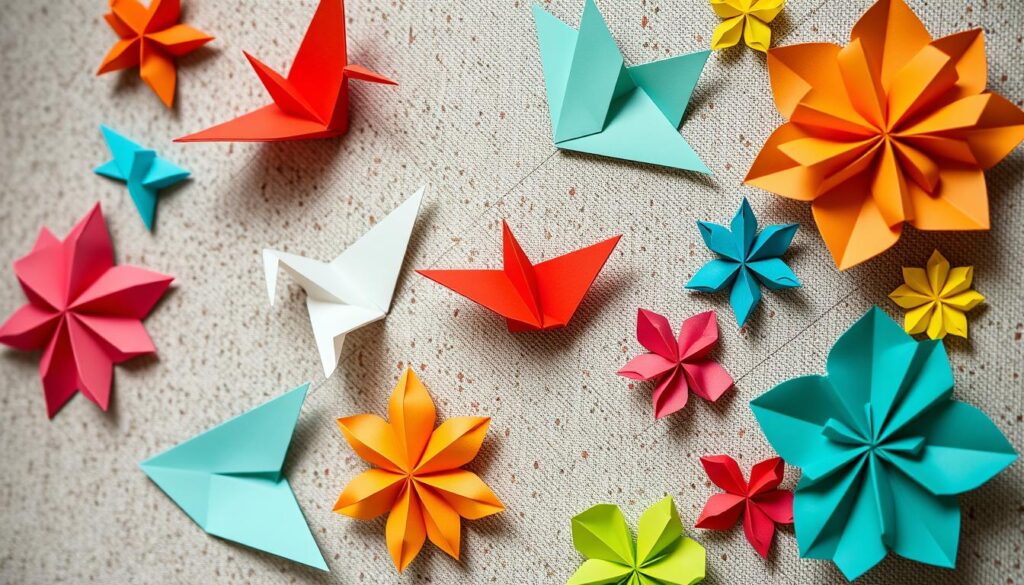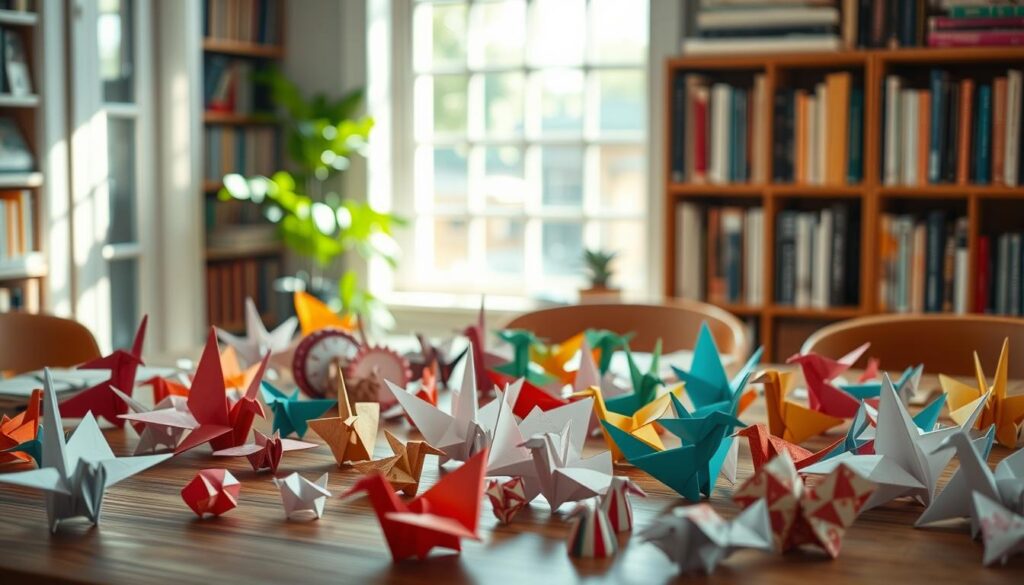Learning origami can be tough, especially remembering all the folds and patterns. But, there’s a way to make it easier. We can use mnemonic techniques to boost our memory and get creative with paper. This article will show you different memory aids and learning strategies to master origami.
Key Takeaways
- Discover mnemonic techniques to enhance your ability to remember origami folds and patterns.
- Explore visual associations, rhymes, and acronyms as memory aids for sequential origami steps.
- Understand how origami can improve your spatial awareness and kinesthetic learning.
- Learn effective study techniques, such as spaced repetition and active recall, to master origami.
- Explore the mindfulness benefits of incorporating origami into your daily practice.
The Art of Origami: Unleashing Creativity with Paper
Origami is a captivating art form that lets us turn a simple sheet of paper into intricate, three-dimensional creations. By learning the origami instructions and paper folding techniques, we can unleash our creativity. This brings our paper-folding dreams to life.
Whether you’re new to origami patterns for beginners or an experienced folder, origami offers endless possibilities. From delicate flowers to whimsical animals, each new fold opens a new world of artistic expression.
Origami is more than a craft; it’s a mind-bending exercise. It challenges our spatial awareness and problem-solving skills. By following the intricate steps of a design, we engage our cognitive abilities. This develops a deeper appreciation for the art form.
“Origami is the closest thing to magic that I’ve ever encountered.” – Robert Lang, Origami Artist
So, whether you’re looking for a creative outlet, a brain-boosting activity, or a moment of mindfulness, origami awaits. Unleash your imagination. Let the paper be your canvas for endless possibilities.
| Origami Techniques | Description |
|---|---|
| Wet Folding | A technique that involves dampening the paper to create sharper, more defined creases and softer, more organic shapes. |
| Modular Origami | The art of assembling multiple origami units into a larger, more complex structure, often with intricate patterns and symmetry. |
| Origami Tessellations | The creation of repeating geometric patterns by interlocking multiple origami folds, often resulting in visually stunning and mesmerizing designs. |
Mnemonic Techniques for Learning Origami Folds and Patterns
Learning origami can be tough, but the right tools can help. We’ll look at two great ways to remember origami: visual associations and rhymes/acronyms. These methods can boost your skills and make you a paper-folding expert.
Visual Associations: Creating Mental Images
One top way to remember origami is through mental images. By linking paper-folding to pictures, we make it easier to recall. For example, when folding a “crane,” think of a bird flying or the paper turning into a bird.
Rhymes and Acronyms: Mnemonics for Sequential Folds
Rhymes and acronyms are also great for origami. They help us remember the order of folds in complex designs. For the “fortune teller” fold, try a rhyme like “Fold, unfold, and fold again, this paper trick will never end!” or an acronym like “FUFA” (Fold, Unfold, Fold, Accordion).
Using these memory aids can unlock your creativity in origami. It makes learning folds and patterns easier and more fun. So, give it a shot and see how it changes your origami experience.
Enhancing Spatial Awareness through Origami
Origami is more than just folding paper; it’s a way to improve our spatial awareness and thinking skills. By folding paper, we learn to see and handle three-dimensional shapes. This skill helps us in many areas of life.
Practicing paper folding techniques boosts our spatial reasoning. We see a flat sheet turn into a complex origami figure. This mental work helps us understand and imagine spatial relationships. It’s useful in architecture, engineering, problem-solving, and decision-making.
The kinesthetic learning in origami also sharpens our spatial awareness. Folding paper, creasing edges, and shaping it helps us remember spatial information. This hands-on experience makes it easier to apply these skills in other situations.
For origami patterns for beginners, learning simple folds and then more complex designs is very beneficial. Our brains are constantly challenged to see the final result and plan the folds. This improves our problem-solving and creative thinking.
In summary, origami is a fascinating and rewarding activity that goes beyond its beauty. Through visual learning with paper folding, we gain better spatial awareness, thinking skills, and problem-solving abilities. Whether you’re new to origami or have been doing it for years, it opens up a world of possibilities for your mind and creativity.
Memory Aids for Origami Beginners
For new origami fans, remembering all the folds can be hard. But, with the right tools, we can master this art. We’ll look at how chunking helps us remember origami steps easily.
Chunking Techniques for Complex Patterns
Our brains work better with smaller pieces of info. This helps us learn origami, even the tricky parts. By breaking down a fold into simple steps, we make it easier to remember.
One way to use chunking is to mark important steps with visual cues. For example, in an origami crane, the first valley fold might remind us of the wings. Each step has a visual clue, making it easier to remember.
Another method is to group similar folds together. This makes the pattern simpler and helps us see the design’s logic. It’s like breaking down a big problem into smaller parts.

Using these chunking techniques, we build a solid base for origami skills. With time and effort, even hard designs become fun and achievable for beginners.
Kinesthetic Learning: Folding as a Memory Tool
Origami, the ancient art of paper folding, engages our senses and physical movements. It helps us learn by doing. This way, we can remember how to fold paper better.
Using origami to learn is special because it involves our hands and body. As we fold, our muscles and nerves help us remember. This makes it easier to recall the steps for each design.
For beginners, folding is very helpful. By practicing basic paper folding techniques, they build muscle memory. This makes it easier to do more complex folds later on.
Origami also helps with spatial awareness and problem-solving. It teaches us to see and understand the paper’s shape changes. This skill can help in other areas of life too.
Origami through kinesthetic learning can deepen our understanding of this art. It’s rewarding for both beginners and experts. Adding these physical techniques to your practice can be very enriching.
“The best way to learn is to do. The worst way to teach is to talk.”
– Richard Feynman
Creative Memorization Techniques for Origami Masters
If you’re an advanced origami fan, you might need more ways to remember your folds. We’ll look at storytelling and visualization. These methods help you picture origami patterns and steps clearly. This makes them easier to remember and do.
Storytelling and Visualization Methods
Storytelling is a great way to remember complex origami. By linking the steps to a story, you create a mental map. This makes the process more fun and easy to follow.
- Give your origami a personality or a story. This makes the folds more memorable.
- See each fold as a scene in your story. Use bright images to help you remember.
- Practice telling your story. Imagine walking through the origami steps as you narrate.
Visualization is also key for remembering origami. By picturing the model in your mind, you can keep its shape and structure in memory.
- Look closely at the origami model. Notice its special features and the order of the folds.
- Close your eyes and recreate the model in your mind. Imagine every fold and crease.
- Do this exercise often. It will improve your ability to remember origami patterns.
Using storytelling and visualization together can take your origami skills to the next level.

| Mnemonic Technique | Key Benefits |
|---|---|
| Storytelling |
|
| Visualization |
|
“The art of origami is not just about the final creation, but the journey of visualizing and unfolding the pattern in your mind.” – Keiko Nakazawa, Origami Master
Origami as a Mindfulness Practice
Trying out paper folding techniques can be a deep experience in mindfulness and meditation. It helps us focus on the now and the detailed steps of origami. This can bring calm, concentration, and peace, improving our overall health.
Origami, the art of folding paper, is known for improving our spatial awareness and problem-solving. But it does more than just boost creativity and thinking skills. When done mindfully, origami as a mindfulness practice can greatly improve our mental and emotional health.
Getting lost in the folds and patterns of origami helps us focus and be in the moment. The gentle movements and paper handling can calm our minds and connect us to our senses.
- Origami helps us slow down and be fully present, reducing stress and anxiety.
- Folding paper can be like active meditation, improving mindfulness and focus.
- Origami brings calm and peace, helping our overall well-being.
Whether you’re new to origami or have been doing it for years, adding mindfulness to your folding can change you. By using origami as a mindfulness practice, you can connect more deeply with yourself and the world.
“Origami is the art of paper folding, which is often associated with Japanese culture. However, the practice of origami can be a powerful tool for mindfulness and meditation, transcending cultural boundaries.”
| Benefits of Origami as a Mindfulness Practice | Techniques for Mindful Origami |
|---|---|
|
|
Effective Study Techniques for Mastering Origami
To truly master origami, we need to use effective study techniques. Two key methods are spaced repetition and active recall. These can help us understand origami folds and patterns better.
Spaced Repetition and Active Recall
Spaced repetition means reviewing origami at set intervals, not all at once. This strengthens our brain’s neural pathways, helping us remember longer. By regularly revisiting origami concepts, we build a strong foundation.
Active recall makes us actively recall information from memory, not just passively review it. When we practice origami, we test our knowledge. This strengthens our understanding and makes it easier to use origami patterns in the future.




